Easy Sarson Ka Saag (Stovetop & Instant Pot)
Here’s how to make traditional Punjabi-style Sarson Ka Saag (Mustard Greens & Spinach Curry). This recipe includes both stovetop and Instant Pot instructions, plus substitutions if you can’t find mustard greens. Ready in under 1-hour, this recipe is the easiest path to this nostalgic dish. Tested to perfection!
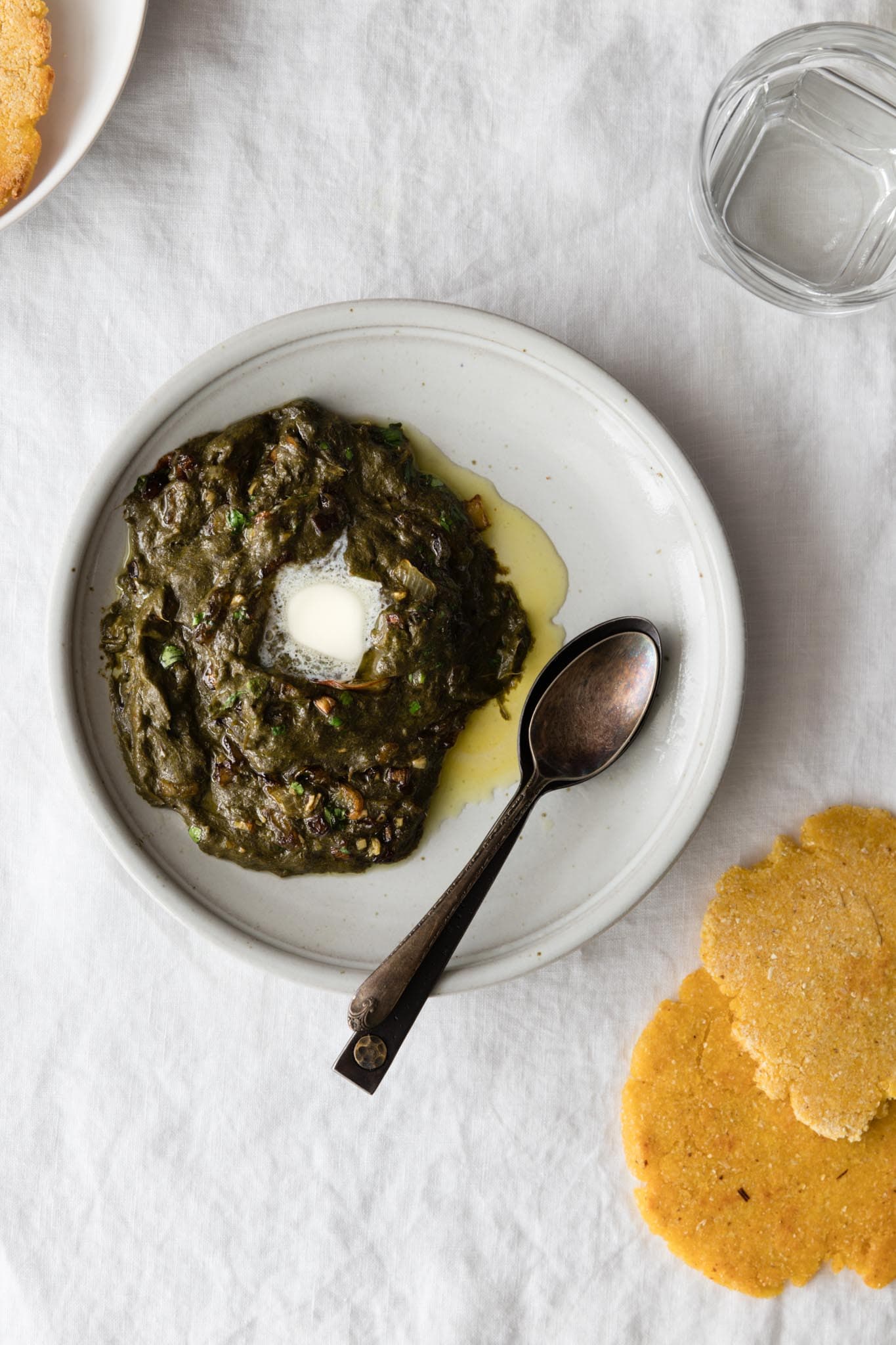
Want to save this post?
Enter your email below and get it sent straight to your inbox. Plus, get recipes & tips every week!
“I’ve made this 3 or 4 times now, and it always comes out delicious! Thank you so so much for sharing!”
Gabby
Imagine having to stop yourself from eating 1.5 pounds of greens. That’s Saag. You’d think it’d be bitter or even an acquired taste. But really, all you need is a bite and it just hits differently. Scoop it up with Makai ki Roti (cornmeal flatbread) on a chilly evening and you’ll know why it’s Punjab’s iconic meal.
More Greens: Palak/Saag Paneer, 30-Minute Aloo Palak
Navigation
- What Is Saag, Particularly Sarson Ka Saag?
- Notes On The Ingredients
- How To Make Sarson Ka Saag (IP Or Stovetop)
- About Mustard Greens
- What Other Greens Can I Use Besides Mustard Greens?
- How To Double This Recipe
- More Tips On Making Sarson Ka Saag
- What To Serve With Sarson Ka Saag?
- Easy Sarson Ka Saag Recipe
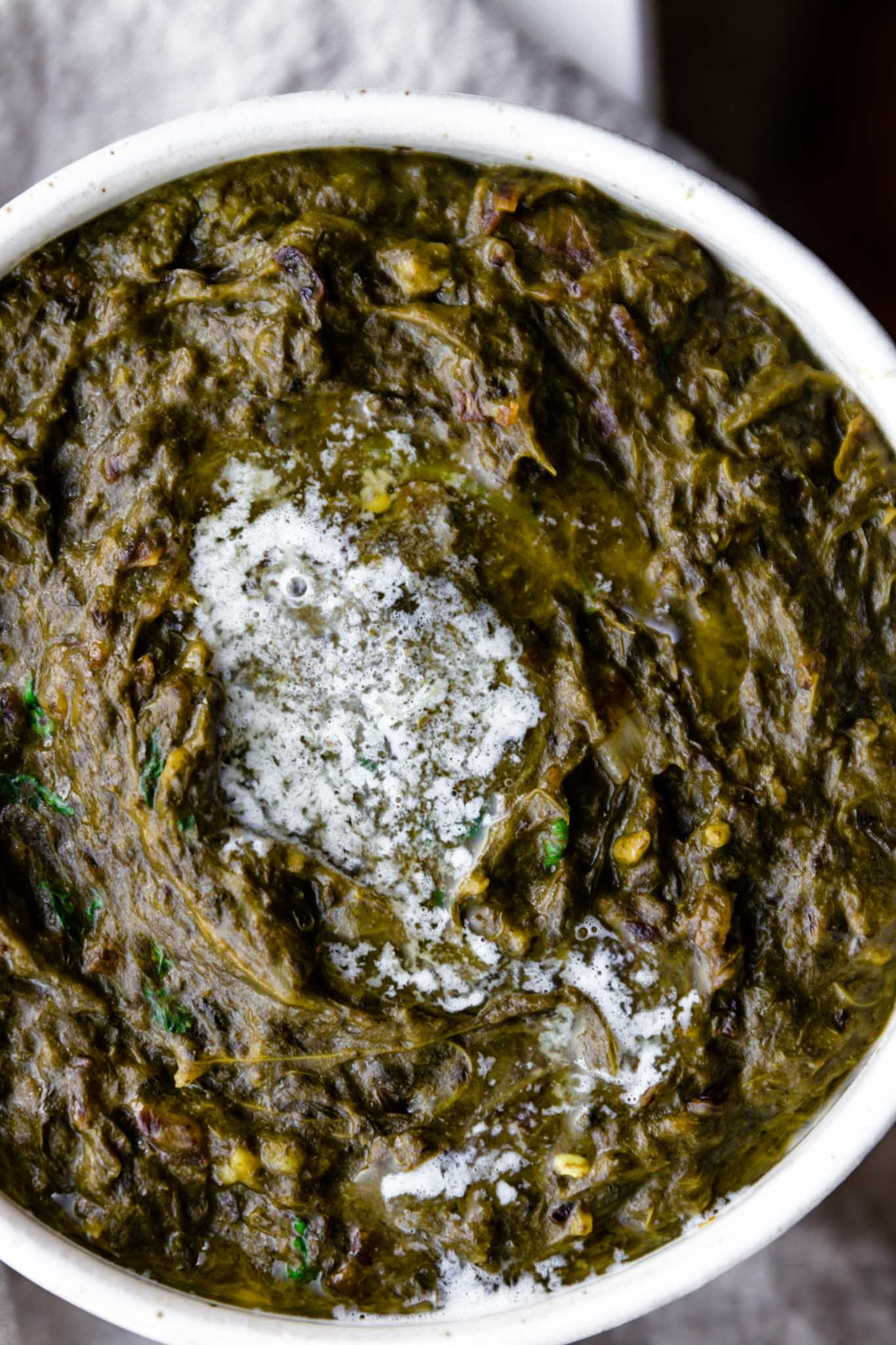
What is Saag, particularly Sarson Ka Saag?
The word Saag simply means vegetable greens. In context, Saag is used to describe stewed or puréed greens. Any type of greens can be used in Saag, but mustard greens (called Sarson) are the most common in Pakistan and India.
In Punjabi cuisine, Sarson Ka Saag (or Sarson Da Saag) is often paired with flaky cornmeal flatbread (makai ki roti).
I learned how to make Saag from my mother-in-law. She was visiting when I saw mustard greens at a farmer’s market, and I knew my collection of Punjabi recipes was to get a welcome addition.
Ingredients for Sarson Ka Saag
This Saag recipe requires just 11 ingredients, 12 if you must count salt.
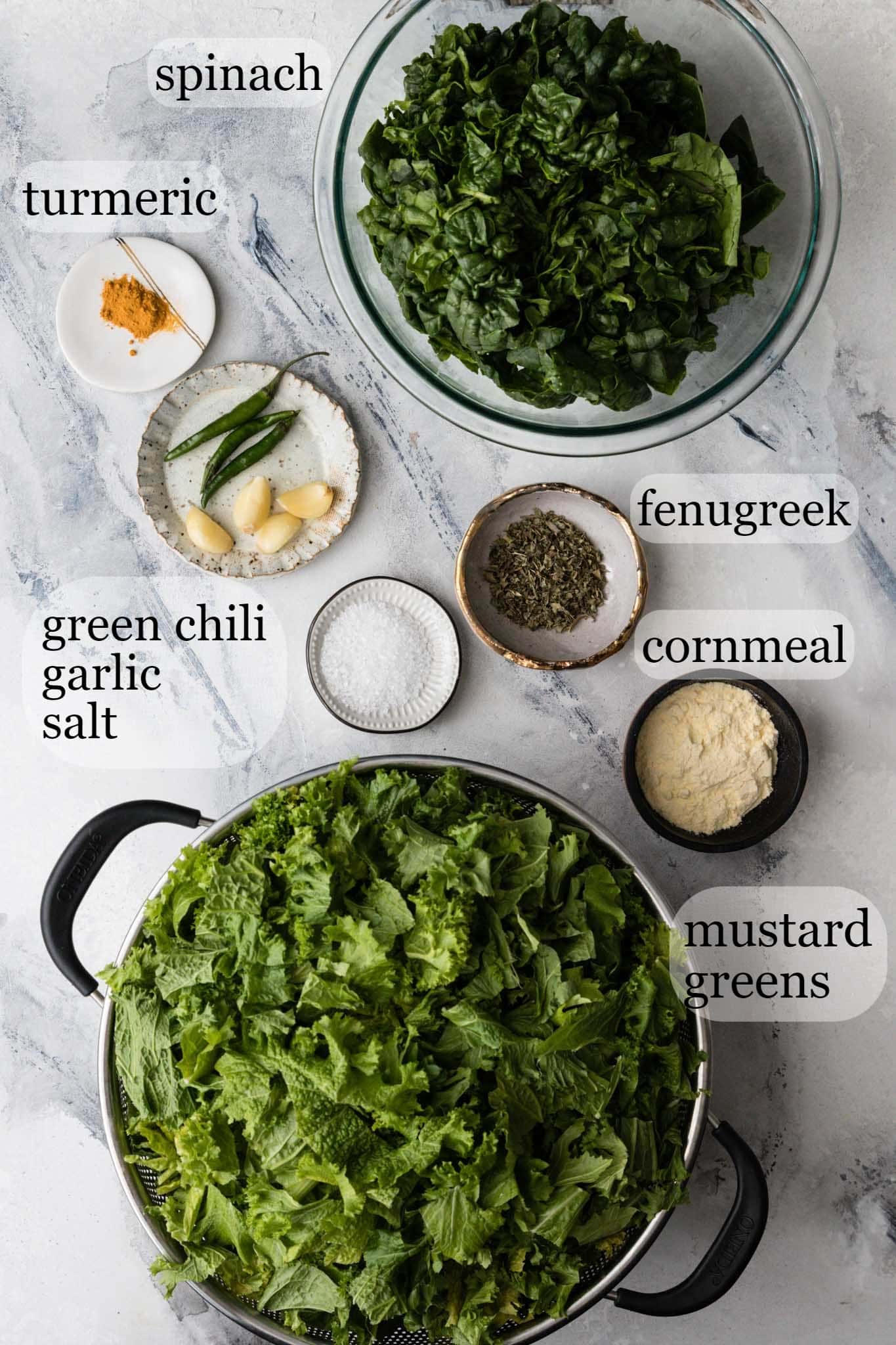
- Mustard Greens – The star ingredient here. You can use fresh bunches, pre-packaged, or even frozen. Scroll below to learn more about mustard greens, where you can find them, and what other greens you can use in place of them.
- Spinach – Spinach is almost always used in Sarson Ka Saag and helps offset the bitterness of mustard greens. Frozen or baby spinach also works!
- Green Chili Peppers – Because Saag is made without many spices, a good amount of green chili peppers are used to give heat and flavor. You can use Serrano or Thai chili peppers.
- Garlic – My mom-in-law doesn’t include garlic, but I found most traditional recipes use it. Plus, I tested & preferred it with the garlic.
- Turmeric Powder – The only spice you’ll need. Like Baingan Bharta, Saag doesn’t need many spices, and gets its complexity from the method of preparation and a good dose of tadka (tempering).
- Yellow corn flour – Used to thicken the saag. Corn flour is finer than cornmeal, but you can also use cornmeal if it’s finely ground. I found coarse, stone ground cornmeal to be gritty in Saag. Chickpea/gram flour (besan) is a perfectly good substitute, and I’ve even used masa harina with good results.
- Dried Fenugreek Leaves (Methi) – I use dried methi but fresh would be a great, albeit hard to find, substitute. (Use leftover methi in Mixed Vegetable Curry or Butter Chicken!)
Tarka Ingredients
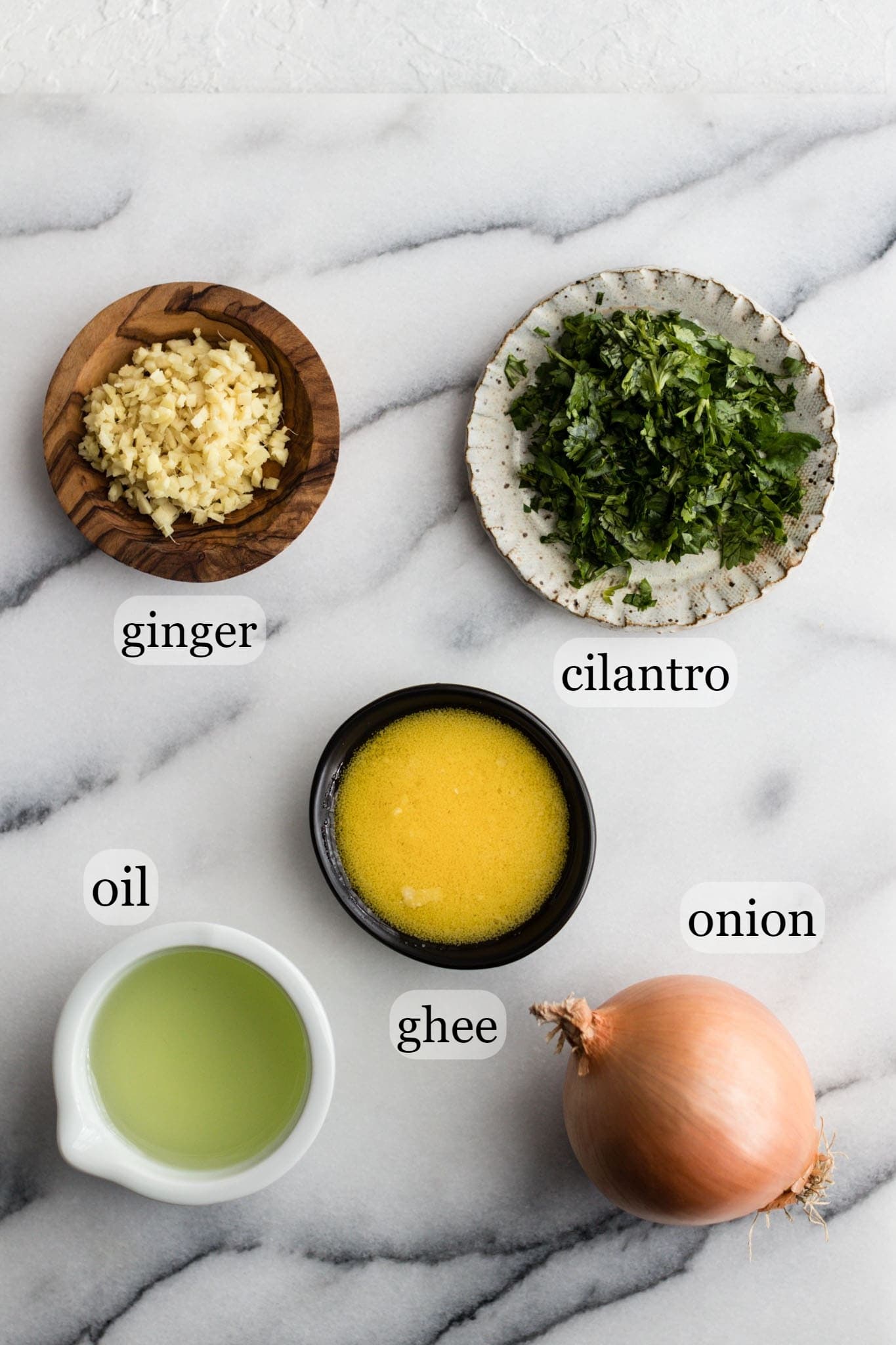
- Onion: Stick to a small-sized onion here. Too much and it’ll impart a sweet taste onto the saag.
- Oil & Ghee/Butter – Use any neutral oil such as grapeseed or avocado. I love blending oil and ghee or butter for the tadka but you can easily make it vegan by omitting the ghee or butter.
- Ginger – A good dose of ginger adds a beautiful flavor without overpowering the Saag. Instead of crushing the ginger, finely chop or mince it so it doesn’t clump up in the tadka.
- Cilantro: For garnish.
How to make Sarson Ka Saag
- Start by cooking the greens, green chili, garlic, turmeric, and salt with some water in your Instant Pot or Dutch oven. Don’t worry about crushing the garlic or even mixing this beautiful pile of greens.

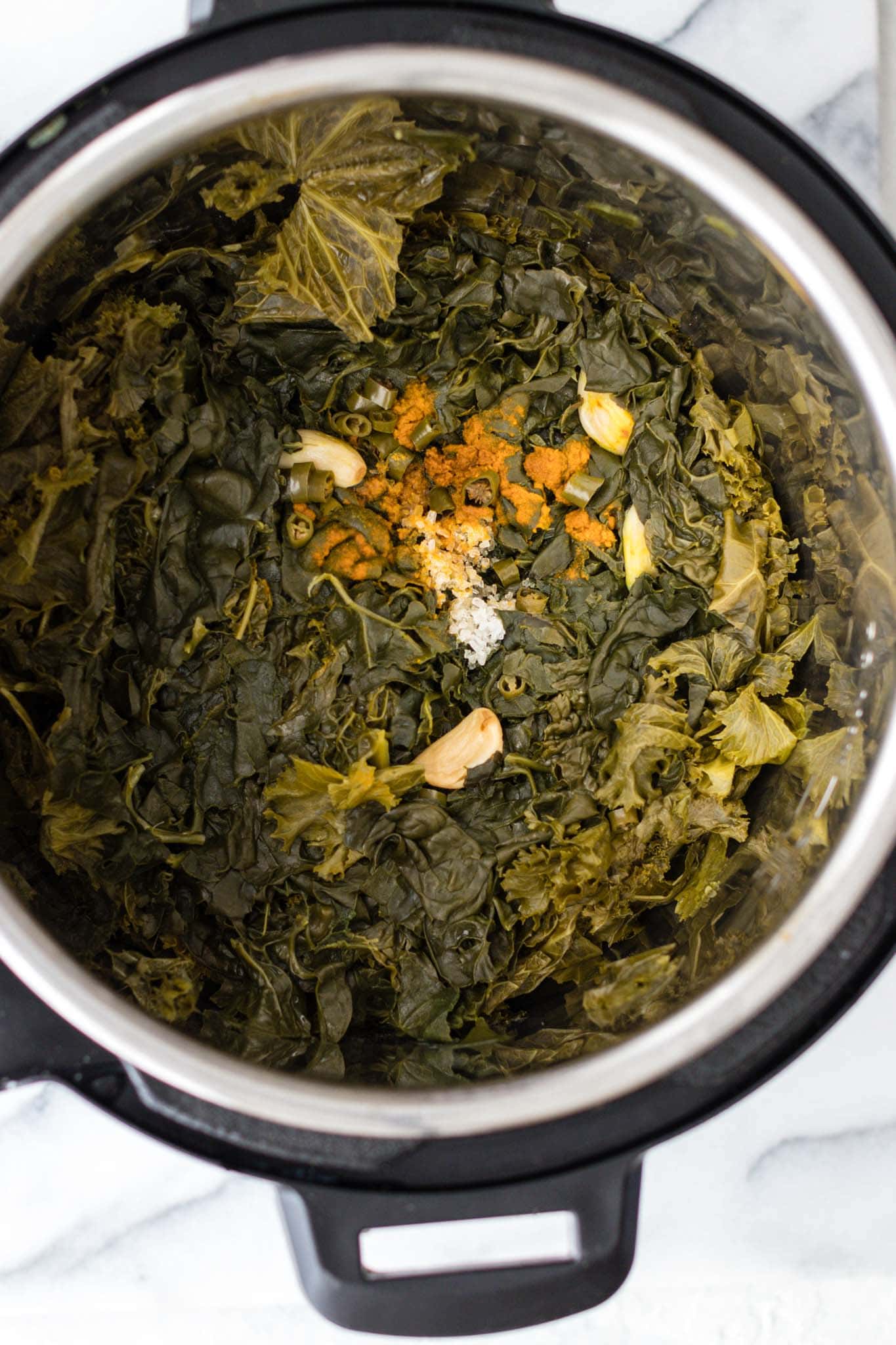
- Once cooked, stir the saag, crushing the garlic as you mix. Then use an immersion blender or transfer to a food processor to blend it into a rough purée.
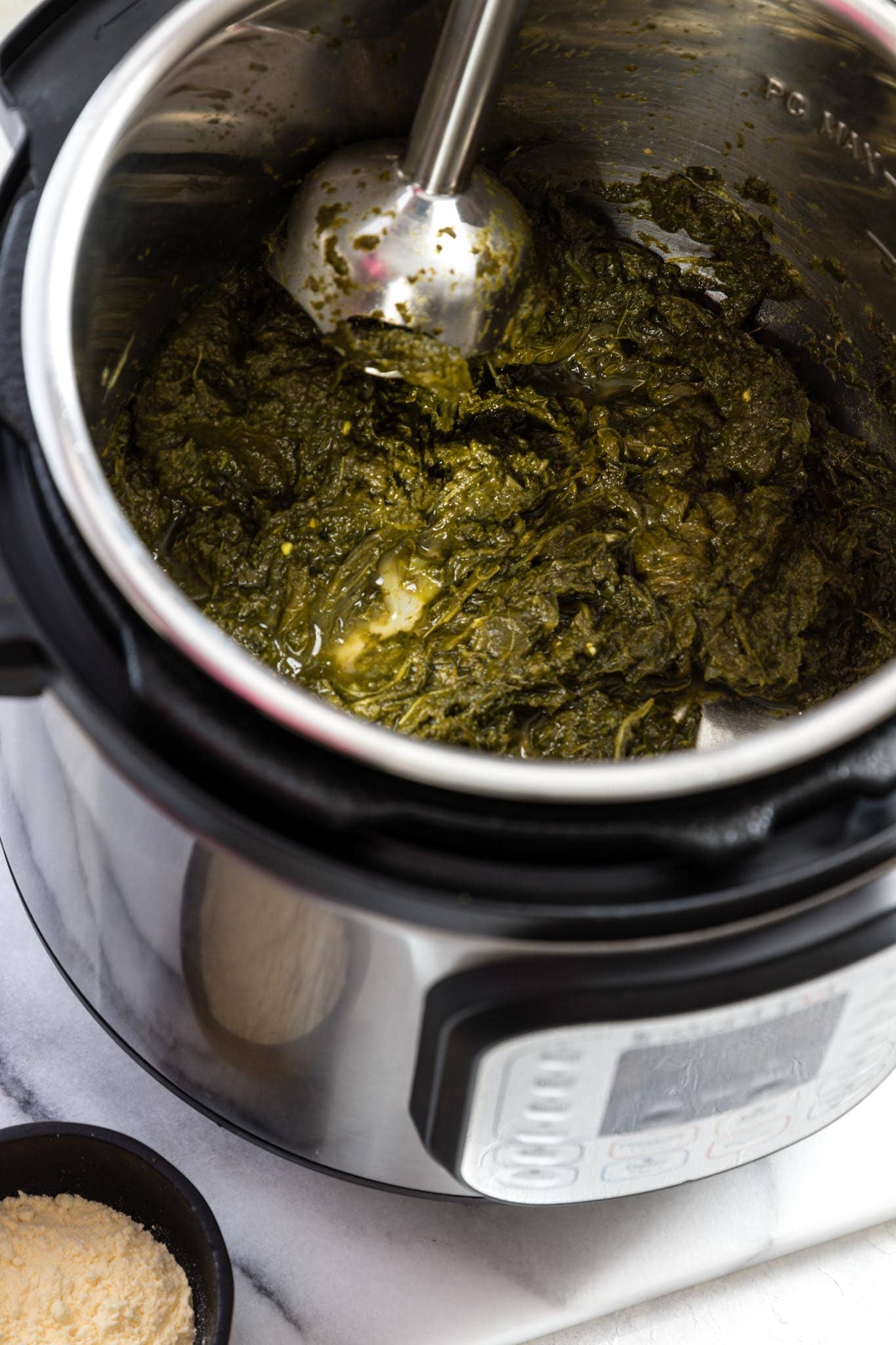
- Next, add cornflour (or fine-ground cornmeal) and start cooking to thicken the saag and remove the floury taste.
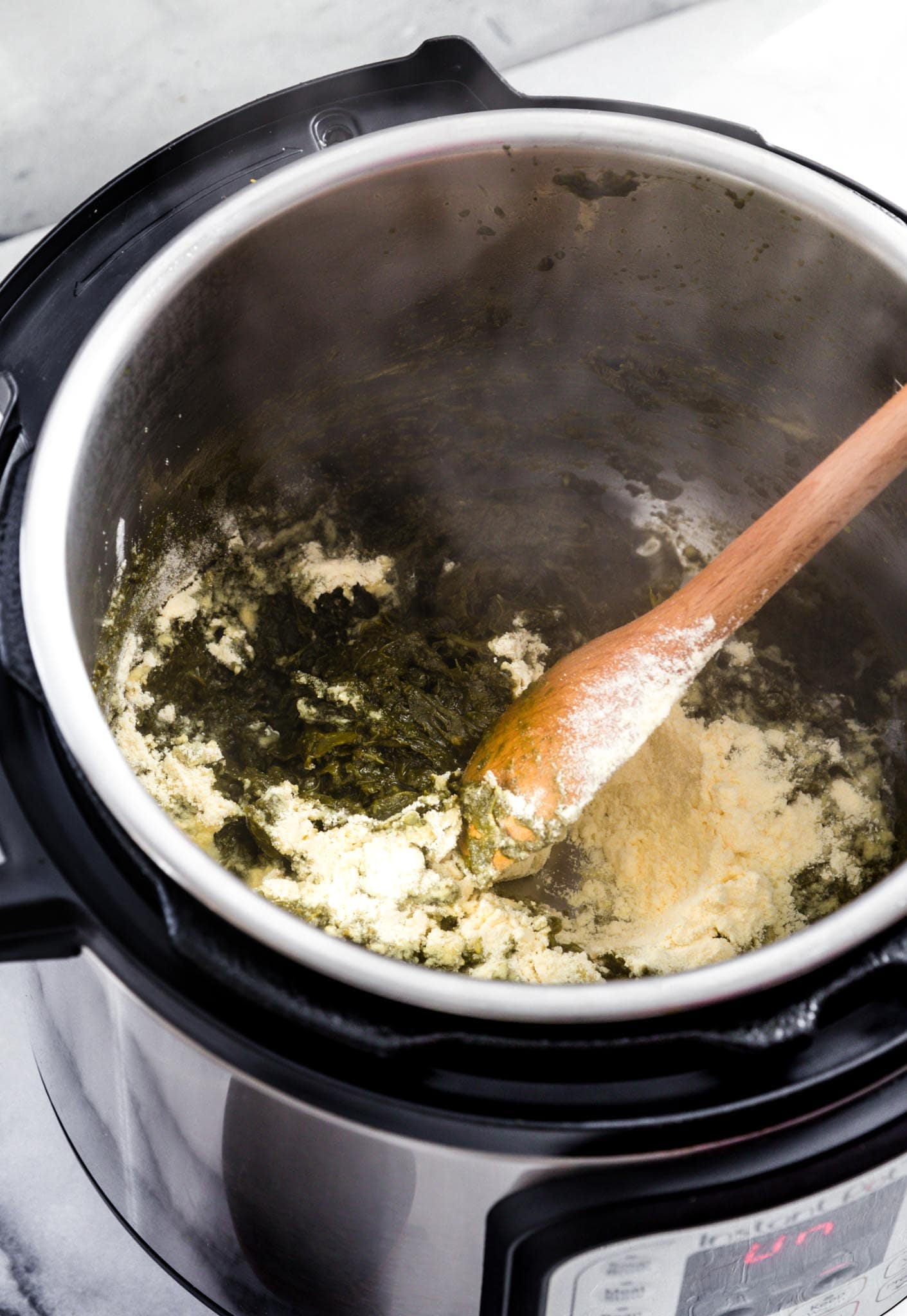
- Stir in the dried fenugreek leaves (methi). Add (preferably boiling) water to help cook the corn flour and methi.
- On stovetop, turn the heat to low and proceed to the Tarka.
- Instant Pot: If you’d like, you can turn the Instant Pot on Saute – Less while you brown onions for the tadka. Don’t worry about bits on the bottom. They’ll be deglazed when the tadka is added.
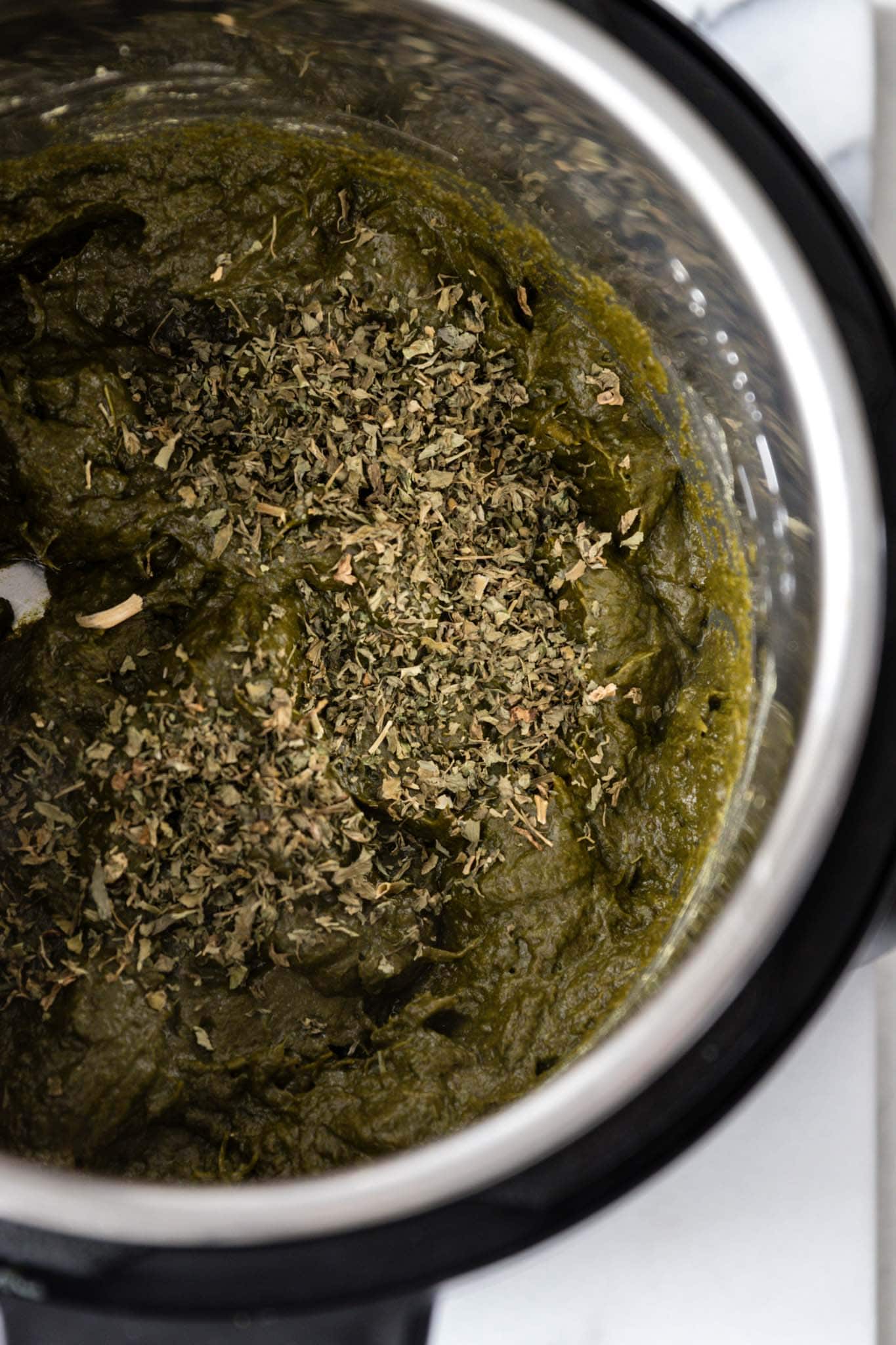
- For the Tarka: In a medium skillet, sauté some chopped onion in oil & ghee until nice and golden. Add a good heap of minced ginger and allow it to cook for another minute.
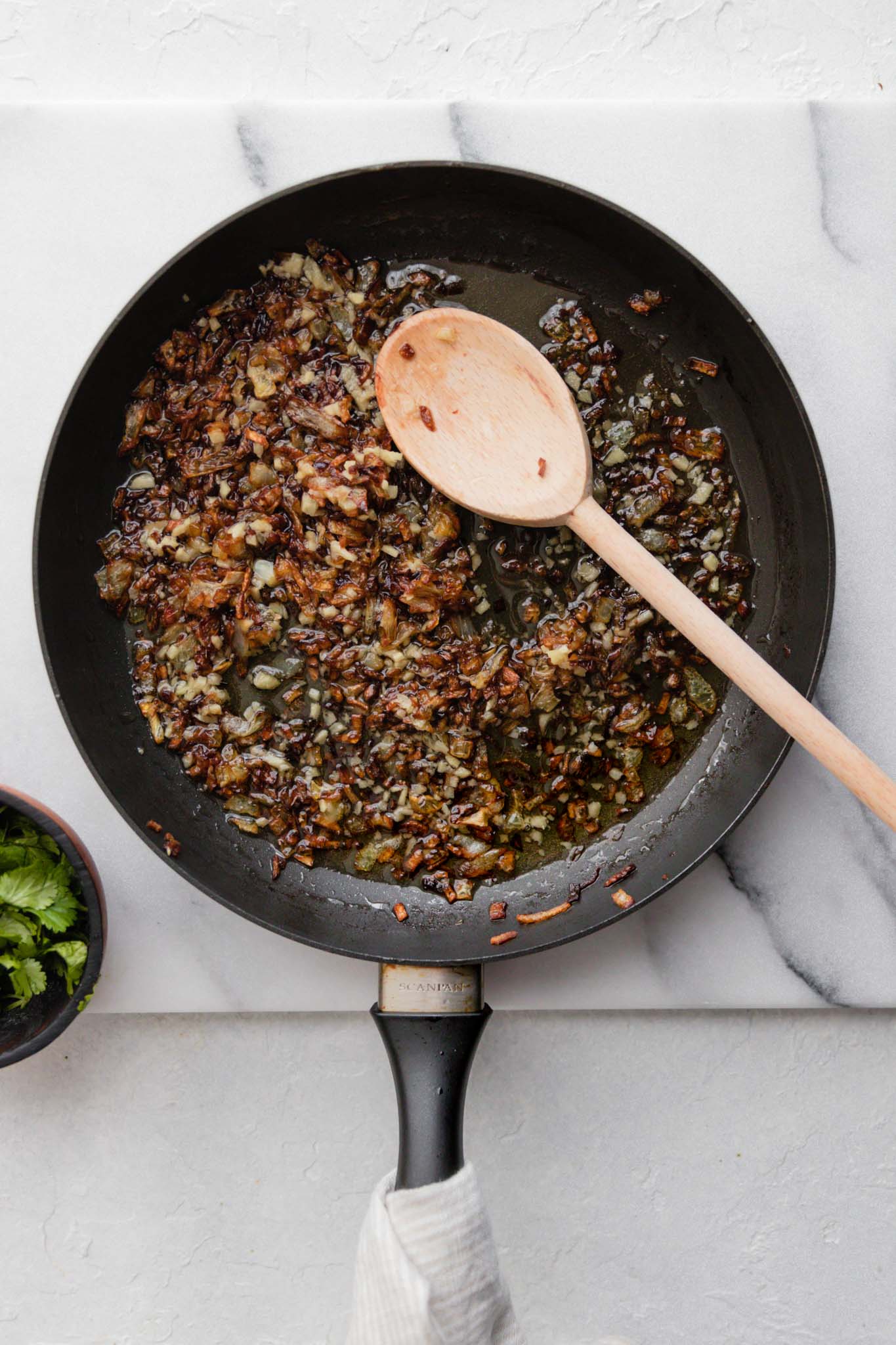
- Transfer this tadka to the Saag and garnish with cilantro.
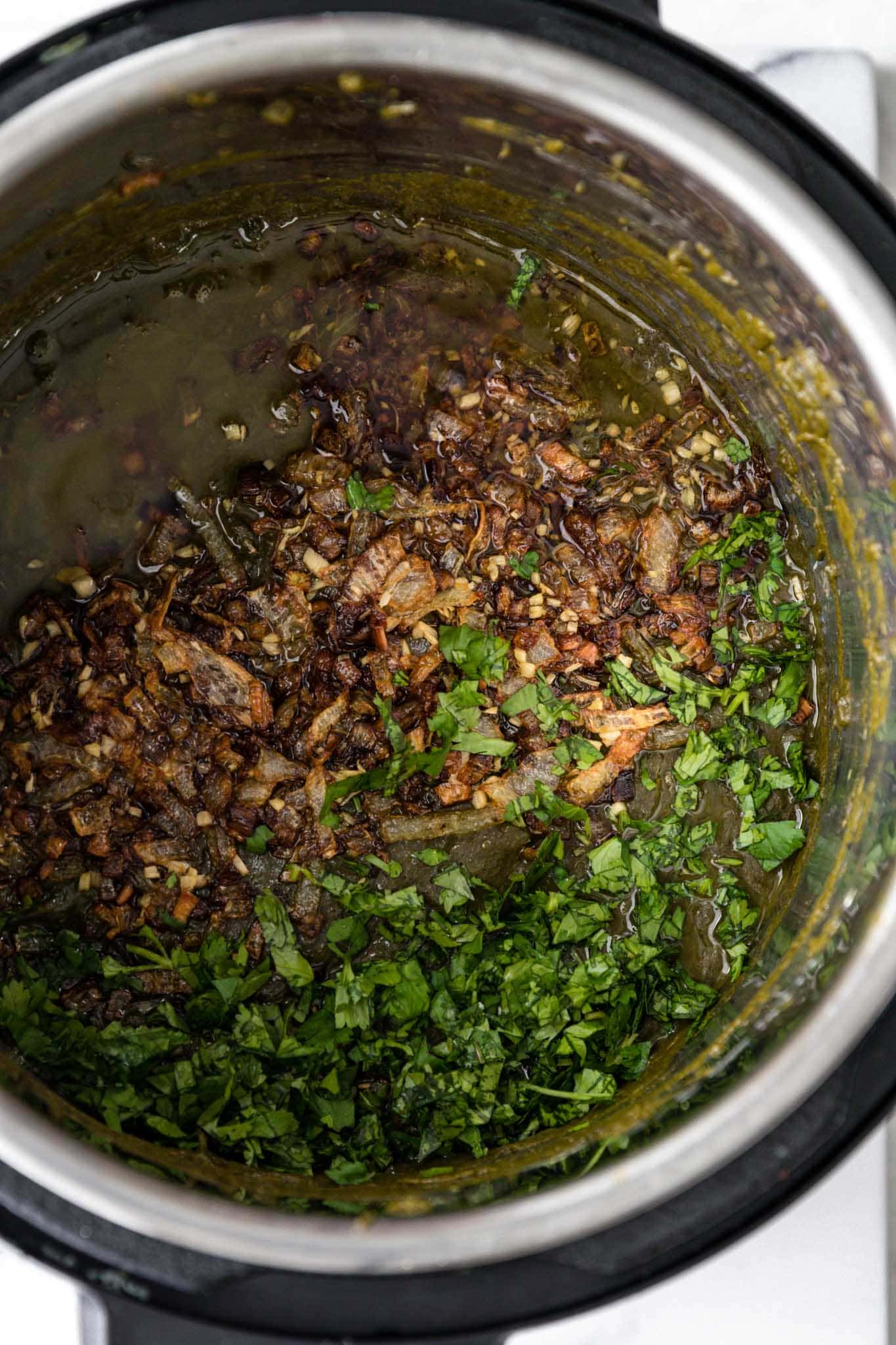
About Mustard Greens
Mustard greens are the leaves of the mustard plant, which has been around since prehistoric times (source). The seeds of the mustard plant are used as-is, or to make mustard (the condiment), mustard powder, and mustard oil.
There are many varieties of mustard greens, and I assume my American mustard greens are different from the mustard greens found in India & Pakistan.

Where to Find Mustard Greens
Fields of mustard greens may be common in Punjab, but they’re harder to find in different parts of the world.
If you’re in Texas, HEB carries mustard greens throughout the winter. They also sell pre-washed/pre-cut mustard greens which are a great time-saver.
If you can’t find them at your local grocery store, Asian grocery stores often carry mustard greens. Some South Asian grocers carry them as well. In any case, I’d try calling to check before making the trip or ordering.
What other greens can I use besides Mustard Greens?
If you can’t find mustard greens, here are some good substitutions:
- Broccoli Rabe (Rapini). A couple people have tried this recipe with them and they reported great results.
- Turnip Greens. I’ve tried using 1 part turnip greens and 1 part mustard greens and it came out delicious.
- Kale could also work, though I haven’t tested it myself.
- Broccoli is another easy-to-find vegetable that I’ve often seen used in Saag.
- Lastly, you can always just use more spinach in place of mustard greens.
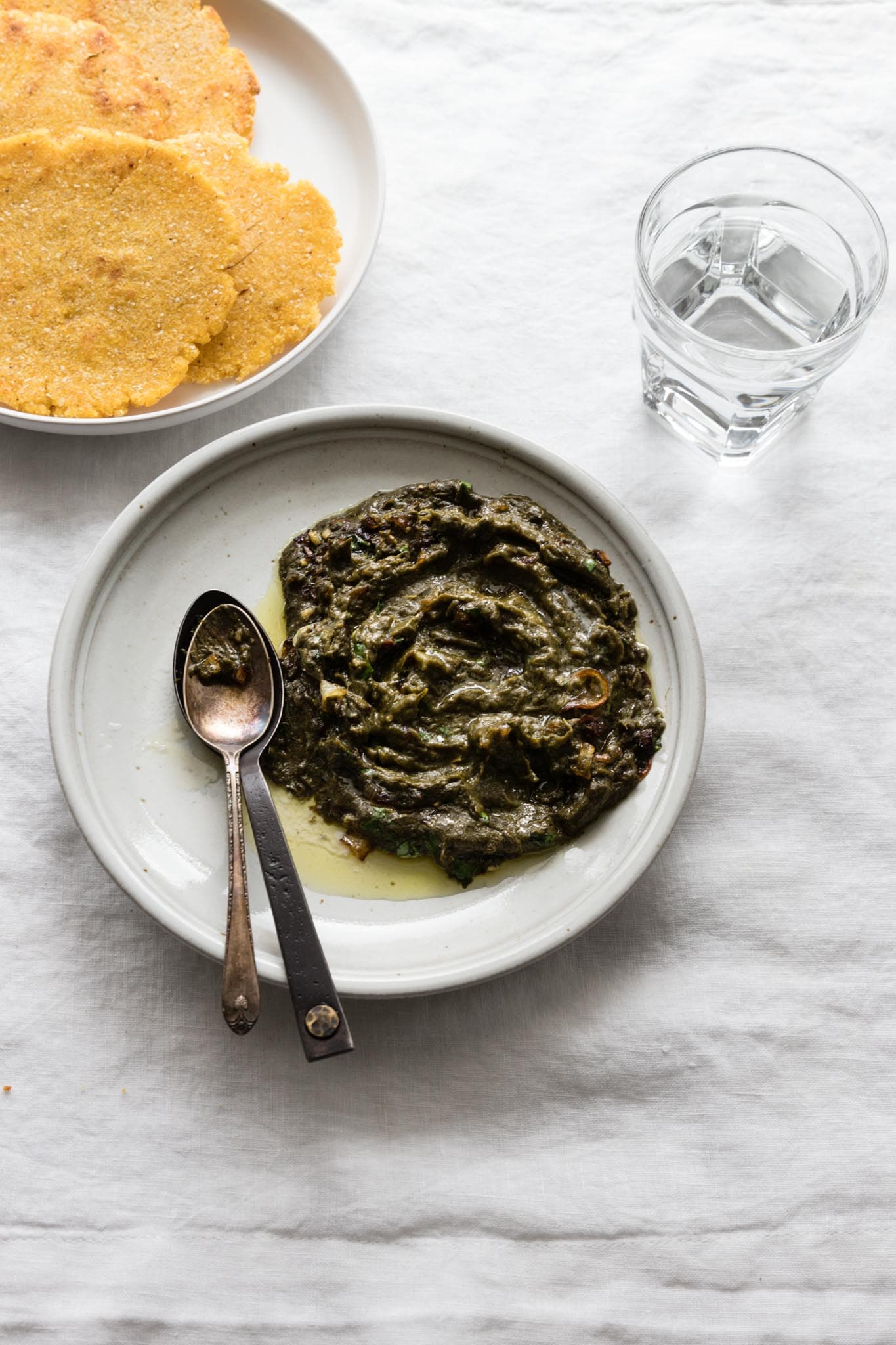
How to Double This Recipe
Because the leaves are packed in the 6 qt Instant Pot, it’d be difficult to double without first wilting them. If making on the stovetop, simply use a larger dutch oven, or wilt the greens before adding more.
Freezing Tips
Saag is very freezer-friendly. Freeze saag after blending, but before adding the tadka. When ready to eat, thaw, reheat on the stovetop, and then finish off with the tadka.
More Tips on Making Sarson Ka Saag
- This is a preference thing, but I like to purée the saag just enough so that it’s smooth but still has some texture.
- After cooking the Saag, if you find it needs a bit more spice, use red chili flakes as they don’t need to cooked like red chili pepper would.
- The hard stems create bitterness, so try to remove them as much as possible.
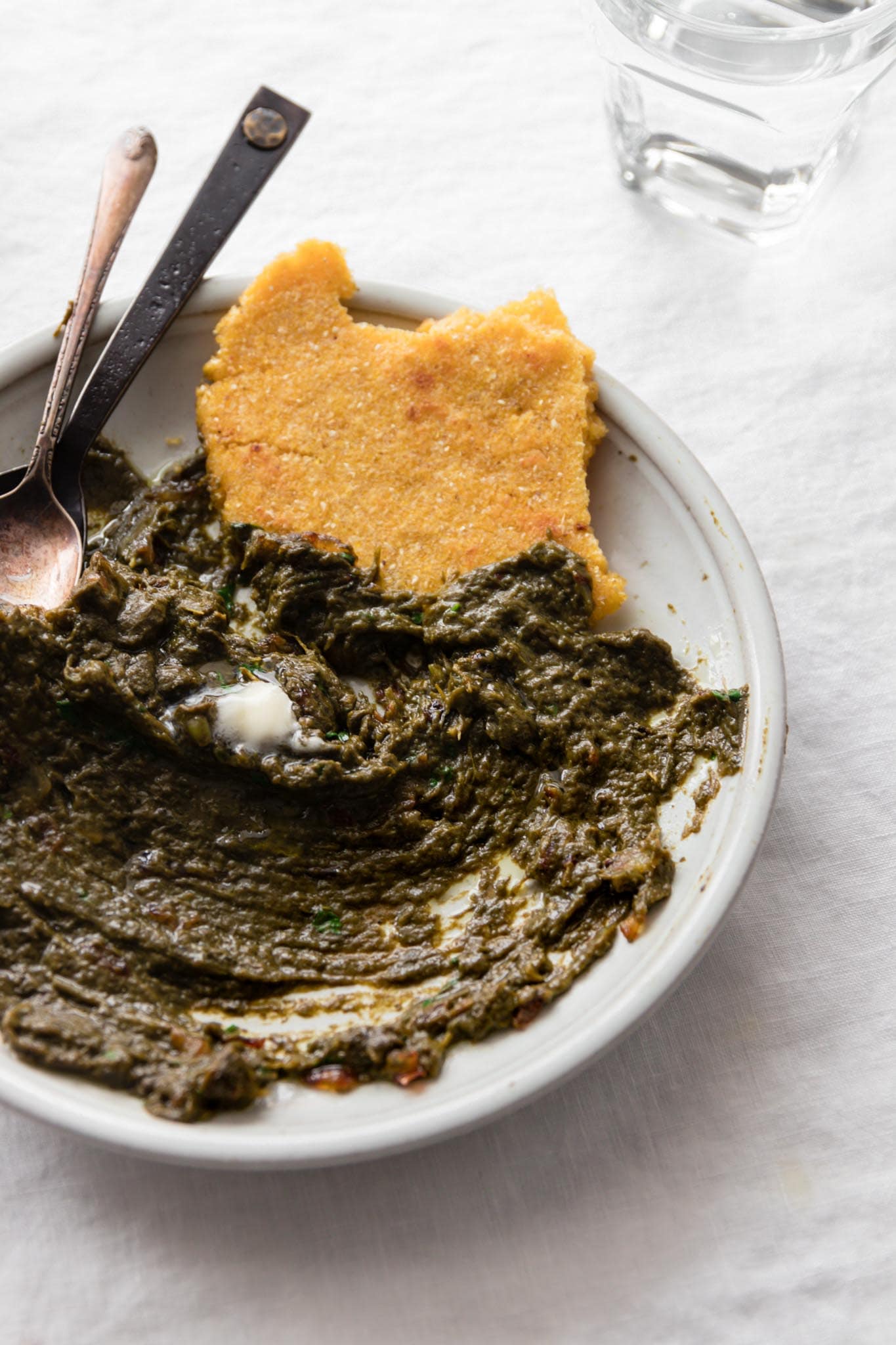
What to serve with Sarson Ka Saag?
Saag pairs well with any type of roti, naan, or even corn tortillas, but makai ki roti (cornmeal roti) is its iconic complement
I usually prepare a quick makai ki roti by mixing 200 grams of cornmeal with a generous pinch salt and adding 1 cup boiling hot water. Mix with a spatula, then cover and set aside until cool enough to handle. Roll out as you would a regular roti, and cook on a nonstick pan over medium heat. If you’d like, I can work on a more thorough recipe. Just reach out and let me know!
For another recipe that will have your family devour a pot of greens, try my Spinach and Potato Curry recipe!
More Punjabi Curry Recipes You’ll Love
- Easy Baingan Bharta (Oven Roasted/Broiled Eggplant Curry)
- Spinach and Potato Curry – Aloo Palak (Easy & Authentic)
- Kadhi Pakora (Instant Pot & Stovetop)
- Matar Paneer
- Chana Masala (Authentic Chickpea Curry)
I hope you get a chance to try this recipe! If you do, let me know in the comments below! If you’re on Instagram, please tag me so I can see your creations. I love hearing from you!
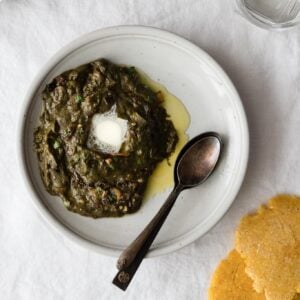
Easy Sarson Ka Saag (Stovetop & Instant Pot)
Watch the Video
Ingredients
Saag
- 2 cups (1/4 cup for Instant Pot) water for Stovetop
- 2 bunches (~1 lb/454g after stemming or 16 oz packaged or frozen) mustard greens*, washed, hard stems removed, and roughly chopped
- 1 bunch (~1/2 lb/227g after stemming) spinach , washed, hard stems removed, and roughly chopped – sub baby spinach or 5-6 oz frozen spinach
- 3-4 small (~4-5 g) Thai/bird's eye green chili peppers, stemmed and roughly chopped
- 4-5 garlic cloves, leave whole – will be crushed later
- 1/4 tsp turmeric powder
- 1 1/4 tsp kosher salt
- 1/4 cup yellow corn flour or fine ground cornmeal, or sub chickpea flour (besan) or masa harina
- 1 1/2 tbsp dried fenugreek leaves (methi)
Tadka (Tempering)
- 1/4 cup neutral oil
- 3 tbsp ghee or butter, or sub more oil
- 1 small (~150-190 g) onion, finely chopped
- 2 tbsp minced ginger
- 2-3 tbsp cilantro leaves, chopped
- pat of butter, for serving
Instructions
Stovetop
- Heat a (preferably nonstick) 5 qt Dutch oven over medium heat. Add the mustard greens, spinach, green chili peppers, garlic, turmeric, and salt along with 2 cups of water. No need to mix. Cover and allow to simmer for 1 hour.
- Turn off the heat. Uncover and stir the saag, crushing garlic cloves as you mix. Use an immersion blender or transfer to a food processor to blend into a rough purée. If you see any tough stems, remove them.
- Turn the heat back on to medium-high. Add corn flour and cook for 3-5 minutes to remove the floury taste. Add the dried fenugreek leaves (methi) and stir to mix. Taste and add salt, if needed.
- Reduce the heat to low-medium, add 1 cup (preferably boiling) water, and allow to simmer while you proceed to the tarka. Stir occasionally. If needed, add another 1/2 cup of water to thin it out.
- Tarka: Heat a medium skillet over medium-high heat. Add the oil, ghee, and onion. Sauté until the onions are deep golden (~6-8 min). Add ginger and sauté for another minute. Stir this tadka into the saag and mix to combine. Garnish with cilantro and give it a stir. Top with a pat of butter. Serve with makai (corn) or regular roti, corn tortilla, naan, or other bread.
Instant Pot
- Add water to Instant Pot, followed by the mustard greens, spinach, green chili peppers, garlic, turmeric, and salt. No need to mix. Secure the lid, seal the vent, and pressure-cook on High Pressure for 20 minutes. Allow pressure to naturally release for at least 5 minutes, and then manually release remaining pressure. Press Cancel to turn off the Instant Pot.
- Open the lid and stir the saag, crushing garlic cloves as you mix. Use an immersion blender or transfer to a food processor to blend into a rough purée. If you see any tough stems, remove them.
- Select Sauté and set the temperature to High. Add corn flour and cook for 3-5 minutes to remove the floury taste. Add the dried fenugreek leaves (methi) and stir to mix.
- Add 1 cup (preferably boiling) water and stir until the water absorbs in the Saag. Taste and add salt, if needed. If it thickens too much, add another 1/2 cup of water to thin it out. Select Cancel to turn off the Instant Pot.**
- Tarka: Heat a medium skillet over medium-high heat. Add the oil, ghee, and onion. Sauté until the onions are deep golden (~6-8 min). Add ginger and sauté for another minute. Stir this tadka into the saag and mix to combine. Garnish with cilantro and give it a stir. Top with a pat of butter. Serve with makai (corn) or regular roti, corn tortilla, naan, or other bread.


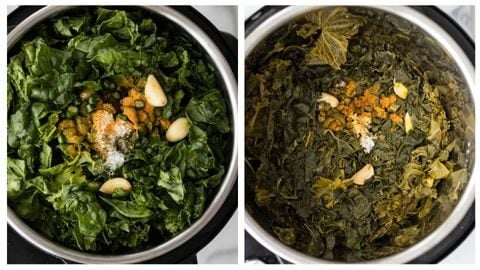
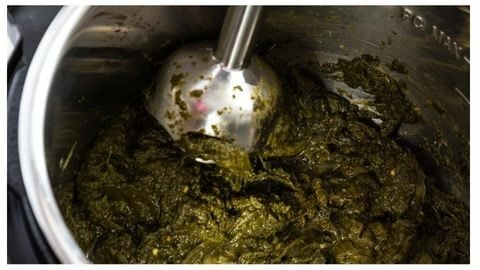
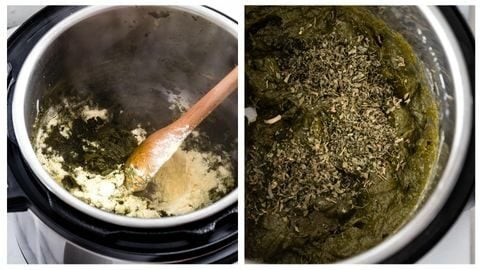
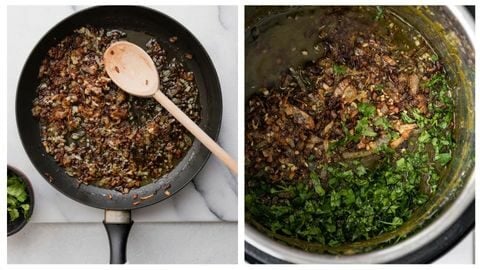
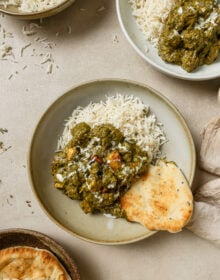
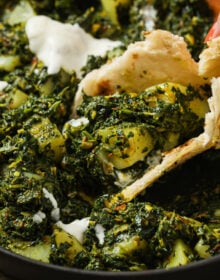


28 Comments on “Easy Sarson Ka Saag (Stovetop & Instant Pot)”
Hi!
Have you tested this recipe using frozen instead of fresh greens by any chance? If so, is there anything to be aware of when following this recipe using frozen greens? For example, would you still perform step 1, simmering with 2 cups of water?
Would love to know if you have any tips for success using the frozen greens or if you recommend just proceeding with the recipe as written.
Thank you in advance!
Hello! I’ve used frozen spinach but not frozen mustard greens. I don’t see a problem with using frozen mustard greens. I’d still cook it the same way, with the same quantity of water, as long as it’s thawed. Would love to hear if you try it!
Delicious – like all of Izzah’s recipes! Reminded me of winters in pakistan.
Thanks so much, Azka!!
Loved the recipe. Just one issue. I used besan and got Lumps in saag. How can I prevent that from happening?
Thanks so much, Sheryl! Hmm..It may be that the besan had clumps going in and didn’t get distributed in time, leading the bumps to stick together instead of disintegrating. I think sifting it may help with that. You can also try adding a little at a time & distribute before adding more.
Try blending it with a little water so it’s like a thin paste before adding to the saag mixture?
Thank you for the suggestion Popeye!